
|   |

|   |
3rd edition of Ashtapadi Festival - Dr Sunil Kothari e-mail: sunilkothari1933@gmail.com March 18, 2013 Now in its 3rd edition, Ashtapadi Festival of dance featuring classic, recent and new choreography of Jayadeva's Gita Govinda (March 9 & 10) at the Kamani Auditorium, New Delhi, received a rousing reception. Not a seat was vacant and the rasikas stood on the side and sat on the gangway. It was presented by the Sri Geetagovinda Pratishthan, Puducherry, established by scholar and cultural organizer late Dr. Raghunath Pani in 2001 to propagate Indian and Odishan culture. His younger brother, the noted scholar and musicologist, Dr. Subas Pani, who has brought out Cds of all the ashtapadis of the Gita Govinda as Sampoorna Geetagovinda, presented during two former editions of the festival, new choreography to the songs of Gita Govinda in Odissi. This year in the third edition, the festival expanded its scope to feature the Gita Govinda in major classical dance forms of India. Of the twenty four songs, thirteen songs were presented in four dance forms - Bharatanatyam, Odissi, Kuchipudi and Mohiniattam. Of these, eight dance numbers were specially choreographed in these four forms and were presented for the first time. Dr. Subas Pani wears many hats including that of an author, translator, composer, scholar with research interests in India's cultural heritage, Jagannatha and Jayadeva. As a creative director of the festival, he had curated the entire festival along with his daughter Sanhati Pani, the festival director. 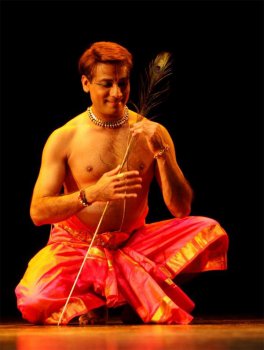 Photo by Avinash Pasricha This year for Bharatanatyam, from Bangalore the celebrated male dancer Sathyanarayana Raju, a disciple of Guru Narmada was invited to present three ashtapadis, choreographed by him with the help of musician Srivatsa. Sathya began with Pralaya payodhi jale and with his regal frame, dignified bearing and a pleasant visage registering bhavas with exquisite glow, captured the beauty of ashtapadi, investing it with sancharis suggestively, how and why each avatara was taken by the Lord, winning the appreciation of the connoisseurs who applauded his final pose of each avatara, be it Matsya, Kurma, Narasimha, Vamana and so on. Set to Ragamalika in adi tala, Srivatsa's singing was full of emotion and added charm to the presentation. The inherent dignity of the Bharatanatyam form was revealed by him in an effortless manner. Here is a dancer who showed how an artiste can elevate audiences to a higher level. In terms of technique, the diagonal lines of fully stretched arms, the kshipta position, araimandi, of the feet, and erect torso, the utplavanas, the jumps showed his command over the form. With restrained abhinaya he maintained the serenity enhancing the meaning of the text and succeeded in bringing out its essence. The ashtapadi Priye Charushile is most suited for male dancers. Set to raga Jhinjhoti in khanda chapu tala, Sathya dealt with it well, but missed the most important stanzas Dehi pada pallavamudaram, Krishna begging Radha with utter submission to place her lotus feet on his head and forgive her. In Imphal, these are the stanzas I have seen Manipuri dancers performing and the audience shedding tears watching and listening to it. It would help Sathya to remember it and perform it to do full justice to the ashtapadi. In the third ashtapadi Kshanamadhuna Narayanamanugatamanusara Radhike in raga Dwijavanthi set to mishra chapu tala, Krishna endearingly tells Radha to gently step on the bed of soft new lotus leaves, so that the enemies of her lotus like tender feet may be put to shame! The rich imageries were interpreted appropriately by Sathya. In the final pose, he showed Radhika in embrace leaning over Krishna's shoulder in bliss. Indeed, Sathya's presentations were the highlight of the festival. The seasoned exponent of Odissi, Madhavi Mudgal presented her disciples in a group choreography, the third song Sarasa vasante in raga Adi Vasanta and tala triputa and ektaali by the legendary Pandit Raghunath Panigrahi, introducing the narrative of the Gita Govinda against the backdrop of Rasa Nritya, with interesting formations by the dancers turning into swaying branches of the trees, waves of Yamuna river, bees hovering over the fully blown lotuses and the gentle breeze blowing with intoxicate fragrance of flowers. The fourth song Chandana charchita nila kalevara depicted the circular and mystic dance with the gopis. Krishna fulfills the desires of the gopis making them feel that he is with each one of them. The suggestion of 'angotsava' in his own body with the beautiful gopis was conveyed with joyous dancing. In terms of nritta, the ashtapadi offers interesting scope, well explored by Madhavi in various choreographic patterns. Arushi Mudgal and other young dancers performed it with zest. 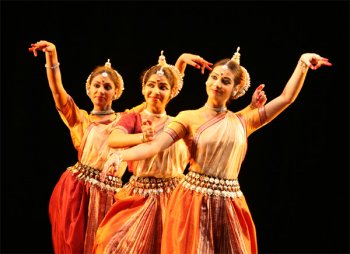 Madhavi Mudgal's group Photo by Susil Pani 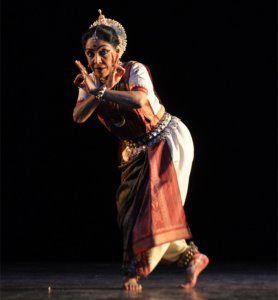 Madhavi Mudgal Photo by Susil Pani Madhavi's solo for the ninth song Radhika tava virahe Keshava in raga Bageshree in taal triputa was adapted from the original music composed by Dr. Subas Pani for Sampoorna Geetagovinda. Radha's plight was depicted intensely but with restrained abhinaya. The stanza in which Krishna is described as 'Indra's handsome younger brother, you are more cruel than even thunderbolt' always makes one wonder at Jayadeva's 'upama' - simile - using it to show the deep anguish Radhika suffers. Madhavi concluded with 13th ashtapadi Yami he kamiha sharanam set to raga Shri in Jhampa taal by her brother Pandit Madhup Mudgal. It was choreographed by Madhavi. It is a soliloquy describing her helplessness and misery in separation from Krishna. She went to meet him for the promised rendezvous stealthily but alas he was not there and was perhaps dallying with those more lucky gopis! Madhavi as vasaksajja adopted Kelubabu's version from Sakhi he keshi mathanamudaram in sanchari. It was most appropriate though it could have been abbreviated in a suggestive manner, as for some of us who have seen it as a part of Sakhi he ashtapadi, expectation was to see another version of the same state so as not to remind of earlier choreography. But this is an aside and does not detract of Madhavi's overall concept. In the audience was Delhi's Chief Minster Sheila Dixit who did the honours and offered flowers to the artistes and musicians, a gracious gesture of a gracious minister who is known for her love of the classical arts. 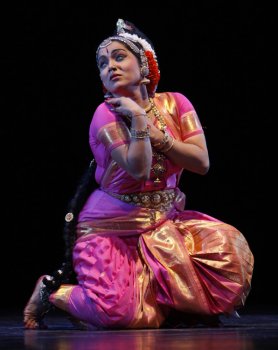 Srimayi Photo by Avinash Pasricha Srimayi performed the fifth ashtapadi Rase Harimiha vihitavilasam set to Ragamalika in adi taal in which Radha speaking to her sakhi, recounts the memories of the Raas as it lingers in her heart. Sanchara dadhara sudha madhuradhwani are hauntingly melodious stanzas and with the notes on flute, Srimayi's getting lost in those nectar like notes, enacting raas movements, with clapping and circling, in front and back directions, the picture of raas leela was evoked in a telling manner. Pallavabhujabala, vallavayuvatisahsram, playing raas encircling several gopis, and Krishna's description with chandrakacharu kapolachachumbita, comparing bright peacock feathers looking like the colourful rainbow, looking like the rain God Purandar, Indra, across the sky filled with dark rain clouds and so on, Jayadeva's description find felicitous expression in Vempati's choreography. Srimayi performed with natural grace and gentle smile. Another gem of choreography of Vempati is of twelfth ashtapadi Pashyati dishi dishi, also composed by P Sangeetha Rao in Ragamalika and adi taal, in which sakhi speaks to Krishna about the emotional state of Radha waiting for his arrival. The description of Radha mistaking darkness of the night for Krishna's dark countenance and trying to hug it and kiss it in confusion, and vigalita lajja, vilapati roditi vasakasajja, becoming utterly shameless, she sobs in loud lamentation, O Krishna how she suffers, are very moving. Srimayi registered the emotions well evoking Radha's state. Beginning with shloka in raga Raageshri and set to the music adapted from Dr. Subas Pani's original music composition of Sampoorna Geetagovinda in raga Pilu and adi taal, Srimayi as Radha in the fifteenth ashtapadi Ramate Yamunapulinavane sang the glory of Krishna, the enemy of demon Mura, engaged in romantic dalliance with gopis on the banks of Yamuna river, the description of Krishna adorning the gopis with musk and ornaments. Jayadeva employs various similes like ever flowing dark hair looking like the very garden of Kamadeva, nail marks on gopi's chest shining like a circle of stars across the sky. Radha asks her sakhi, why if he is playing, should I wait for him alone in desolation in the Kunj? Choreographing this particular ashtapadi, Srimayi took great care of Kuchipudi vocabulary. However, the singer Lalita Sharma's voice was under weather and often failed to maintain the higher pitch. The percussionist had to replace the mridangam with a pair of tabla as the mridangam could not be tuned properly. 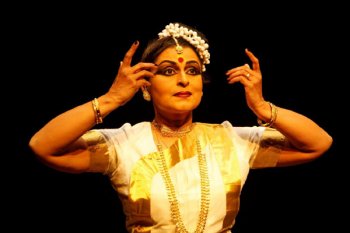 Deepti Bhalla Photo by Avinash Pasricha The seventeenth ashtapadi Yahi Madhava Yahi Keshava is quite well known. Rajani janita guru jagara raga kashaya militanivesham, eyes red on account of waking up all night, in such state Krishna arrives at the Kunj where Radha is awaiting him. Deepti presented it in raga Ahira Bhairav in taal chapu. When Krishna does not arrive at the appointed hour and arrives in the morning after dallying with other gopis, carrying telltale marks on his body, Radha in great unhappiness requests him to leave and not to tell lies. Using Mohiniattam dance technique in sancharis, Deepti accusing Krishna of his 'nirdaya balacharitram' enacted the sequence of Puthana moksham. She described Krishna's dallying with other gopis, enjoying on swing, putting on alata (red colour) on their feet, and pretending that he has come to her. Bhramati abala sabala, why do you hurt me, Krishna et al, was choreographed in Mohiniattam vocabulary imaginatively. With sarcasm, she shows him the flowery bed prepared by her and is distressed. Deepti wove emotional web around those stanzas with intensity. The final presentation was of the twentieth ashtapadi Virachitachatuvachanarachanam, Mugdhe Madhumathanam anugatamanusara Radhike adapted in raga Behag in taal adi as per Dr. Subas Pani's music composition. Sakhis tell Radhika that, Krishna has already asked your forgiveness, is awaiting in his bower, you are decked with all ornaments, move with the graceful gait of a royal swan, making loud tinkling sounds with your jeweled anklets, as the battle drum heralds a warrior, signal to your lover that you have arrived. Jayadeva's stanzas are, as it were full of musical notes, conveying the attraction of his sweet flute. Deepti enacted Kusumashara, sphuritam ananga taranga, suchita parirambhanam and so on the beauty of Sanskrit compounds and suggestions of erotic love play, with dignity and typical charm of Mohiniattam movements. Dr. Subas Pani's curating deserves all the applause. One did at times feel that in case of Mohiniattam and other dance forms, the ragas suggested by him at times, sounded lighter. The musician in him wishes to approach the musical character in a different mode. Also I felt when the complete ashtapadi with Jayadeva's naam mudra is danced, in case of Kuchipudi at least it reminded me of Bhajan sampradaya in the South where the tradition of singing of Gita Govinda is also practiced. The lalita komalakanta padavali of Gita Govinda poses many complex problems. While the classical dance forms with their inherent special movements will be employed by the dancers in abhinaya numbers, one also wants to watch the dhira, gambhira, shanta interpretation, when abhinaya flowers. Nritta when introduced breaks the flow of abhinaya many a time. After the performance, Dr. Kapila Vatsyayan raised an aesthetic issue which critics and sahridayas, connoisseurs would also like to share. If the sessions were of abhinaya only minus nritta, how would it be appreciated? To keep up the interest and attention of the audience with changing times, do the dancers necessarily have to use scintillating nritta movements as decoration? With these reservations, one wishes to congratulate Dr. Subas Pani for the Herculean task of mounting such a festival, which brings the beauty of the Gita Govinda on various levels to audiences of bhinna ruchi. Bharata has said Bhinnaruchir janaha natya ekameva samaradhanam - natya including music and dance is an amazing entertainment which appeals to audiences of different tastes! The brochure, the set of Sampoorna Geetagovinda, display in the foyer, and smooth compering by Sanhati Pani were additional bonus of the festival. One looks forward to the 4th edition. Congratulations to one and all connected with the event.  Dr. Sunil Kothari is a dance historian, scholar, author and a renowned dance critic. He is Vice President of World Dance Alliance Asia Pacific India chapter, based in New Delhi. He is honored by the President of India with Padma Shri, Sangeet Natak Akademi award and Senior Critic Award from Dance Critics Association, NYC. He is a regular contributor to www.narthaki.com, the roving critic for monthly magazine Sruti and is a contributing editor of Nartanam for the past 12 years. Post your comments Pl provide your name and email id along with your comment. All appropriate comments posted with name and email id in the blog will also be featured in the site. |